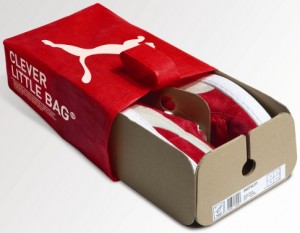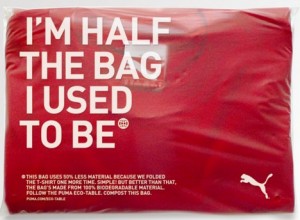 This article is the second of a series of 2, which looks at what Puma has achieved within the realm of their sustainability initiatives. The first instalment looked at the general initiatives of Puma in this area, while the second instalment looks at concrete results that have been achieved.
This article is the second of a series of 2, which looks at what Puma has achieved within the realm of their sustainability initiatives. The first instalment looked at the general initiatives of Puma in this area, while the second instalment looks at concrete results that have been achieved.
Puma Initiatives: Tangible Outcomes as of summer 2012
The systematic and at the same time pragmatic approach has so far yielded respectable results for Puma.
Clever Little Bag

Puma’s ‘Clever Little Bag‘ saves substantial amounts of resources, of the financial and none-financial kind. The main actor in this is a reduction of 65% in paper and cardboard usage. These alone amount a 60% savings (per year) in water, energy and diesel consumption at the manufacturing stage of the bag.
While Puma makes the positive improvements available in numbers to the public, it would be equally interesting to know how much money they save over the course of a year. Chances are it may at least also be in the 60% range.
Half the Bag

By folding their T-shirts simply one more time, they managed to reduce the packaging size by approximately half, saving CO2 emissions and costs during transportt.
Bring me Back

The ‘Bring it back‘ project is in essence Puma’s answer to Marks & Spencer’s collaboration with Oxfam: motivating consumers to bring their discarded garments and shoes back.
The project website states: “Your items are sorted and graded through I-Collect according to over 400 criteria so there’s no waste. Every item gets a new life, whether it is re-used, up-cycled for industrial use, or recycled and turned into new raw materials to produce new products.”
It can be assumed, that they are likely collaborating with textile recyclers as it is not conceivable that Puma would do the sorting themselves. Which would lead to the conclusion that this recycling scheme may be a trial, or already the full blown operational case, for a complimentary income stream for Puma.
Product Range Overhaul
Now this is where it gets really interesting. What do we know about how the whole initiative has impacted, or is impacted, Puma’s product range?
- Puma introduced in 2011 their “Re-Suede” Vegan Sneaker made with recycled materials, and which adds a rice-husk filler to the latex sole to save on energy in manufacturing and agricultural resources.
- And Puma’s CEO told the German business magazine ‘Wirtschaftswoche’: “We are confident that in the near future we will be able to bring the first shoes, T-shirts, and bags that are either compostable or recyclable to the market” following therefore the Cradle-to-Cradle principle.
Environmental Profit and Loss Accounts (E P&L)
The E P&L is in essence an exercise in putting a cash value on internal as well as external risk the company faces with regards to the environmental aspect of their operations.
The sobering reality – based on which possibly above design initiatives might have come into being – was that if the company were charged for all the resources it impacts or consumes currently for free, the would face a huge bill, that would likely cause a financial loss in their (financial) balance sheets.
With this insight they are not alone, and it further initiatives like the ones described above can be expected within the span of only a few years.
What’s Next
We already know, either through official statements or statements made in semi-official circumstances, that Puma’s effort will in essence be focused on their Profit & Loss Accounting approach. Hence,
– an Environmental Profit & Loss accounts by product line is in the makes (launch date unknown)
– as is a Social Profit & Loss accounts for the company as a whole (to come, 2015 as been informally mentioned as initial target date for launch publication)
The current version of overall E P&L is scheduled to be rolled out across the whole of the company’s holding (PPR).
This all said, from profit & loss accounts, life cycle assessment of selected aspects – be it packaging or products – are only a stone throw away, and it can be assumed that as time goes by, the company will increasingly make specific numerical performance data available to their designers embedded into their CAD software. These will likely encompass the data and limitations given in e.g. Restricted Substance Lists, as well as alternative (and ‘better’) materials for products.
—
This article is the second of a series of 2, which looks at what Puma has achieved within the realm of their sustainability initiatives. The first instalment looked at the general initiatives of Puma in this area, while the second instalment looks at concrete results that have been achieved.

